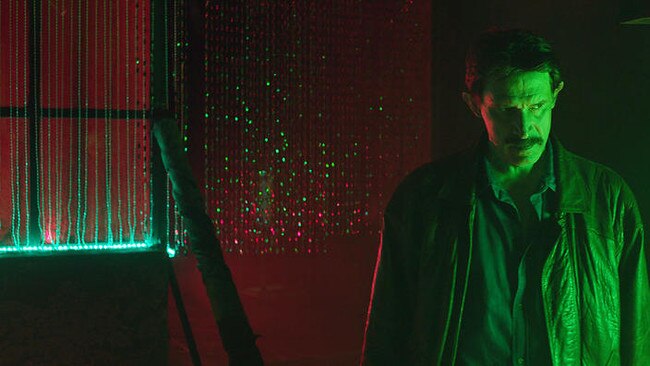Chileans turn procedural on its head in Inspector Rojas: In Cold Blood
A Chilean cop thriller that’s also a contemporary western is an antidote to our discontent over the familiar ‘cops as heroes’ narrative

Cop shows continue to proliferate, even as there is an increasing awareness that, as Alexis Gunderson recently wrote, we’re at a moment in the real world when popular interest in consuming fictional policing as simple entertainment is at its lowest moment in decades. There is understandable discontent in some creative circles with the “cops are the heroes” narrative that characterises most TV police dramas and the way the police-eye perspective reflects the victories and struggles of police over communities being policed.
And as Kathryn VanArendonk also recently wrote in a penetrating essay about crime TV, “a cop’s point of view has become the default way to frame national unrest, including institutional and systemic racism, the capitalist urge to prioritise property over human life, and a political system that benefits those already in power”. As she points out, the cops are still at the centre, “still the point of view we use to interpret the world, still the characters we follow week after week”.
The latest show I’ve just discovered is the classy Inspector Rojas: In Cold Blood, a Chilean noirish procedural, both a cop thriller and a kind of contemporary western. And this finely executed, highly cinematic series certainly doesn’t glorify the local police or focus favourable attention on them. Even as Rojas, a tall, lean, moustachioed cop from Santiago, carrying a weight of demons just under control, played with wonderful self-control by Francisco Merlo, is introduced as a rogue lone wolf investigator hardly indifferent to the injustices perpetrated by the institutions of criminal justice. At times Rojas reminds one of Harry Bosch – Prime Video’s moody, Los Angeles-set detective drama of the same name taking its final bow last June as the Amazon streamer’s longest running original TV series – and his mantra, “Everybody counts, or nobody counts”.
The eight-part series is from the innovative Santiago boutique production company Villano for Chilean broadcaster Mega, directed by Juan Ignacio Sabatini, who also executive produces the series, a creator of highly regarded projects based to a large extent on real events. His work for Chilean public TV Los Archivos del Cardenal following the work of the Vicariate of Solidarity which offered social and legal assistance to those who suffered human rights abuse by the Pinochet dictatorship, was both a critical and popular success. And Red Eyes, his film that explores the relationship between soccer and defeat in Chilean society, is to date the most watched documentary in the history of Chilean cinema.
The drama, enthralling it is too, is to some extent based on the case of the man dubbed “the psychopath of Alto Hospicio”, a mining town located 1800km north of Santiago, which triggered bitter criticism of the police, who failed to conscientiously investigate the cases after the victims, who ranged in age from 14 to 17, began to go missing in November 1999.
The missing girls were from poor families and the police didn’t bother to investigate the disappearances, claiming the teenagers had run away. Eventually, 38-year-old Julio Pérez was arrested after a 13-year-old girl narrowly escaped after being kidnapped, assaulted and left for dead. He confessed to police that he had been kidnapping, raping and murdering teen girls for two years before they caught him and led the police to the bodies of his victims, seven young women between the ages of 14 and 17 whose bodies he had buried in an abandoned mine shaft.
The police had no idea a brutal serial killer had been operating in their town, Silva having killed 14 girls before the police knew of his existence. The case exposed police carelessness that was allegedly the result of social discrimination based on the victims’ low socio-economic standing, the authorities constantly denigrating the poor families during the investigation.
“This is basically a story about discrimination and classism, about gender violence, coloured by the horror of the actions of a sick mind that was allowed to move with total freedom thanks to the negligence of local authorities unable to control their own impulses,” says Sabatini. “Then, Inspector Rojas comes into the story. He’s a foreigner finding himself in hostile territory where he’ll fight little by little to settle his own demons and to get justice.”
As played so intensely by Melo, he’s a figure armed with a kind of bitter cynicism and world weariness, obviously not unfamiliar in the crime world of knight errants, obviously repulsed by his employment in a corrupt society. He seeks some kind of moral justice for the victims of the crimes he investigates, transcending the tawdry and corrupt routines of the legality he encounters in the frontier town. He is bitter, exasperated, and lonely, behind a veneer of taut self-control and seeming indifference. But there’s also charm and a quickening smile when he deals with the families of the victims.
As becomes apparent, his past is complex, a difficult childhood, which saw him move between foster homes and adoption centres before joining the police force looking for some kind of containment. “In this context, Rojas puts up a wall around himself to contain his inner demons, which are conceptually aligned with the hidden demons often found in the most remote of places,” says Sabatini. “The wall begins to crumble just before he embarks on this journey. It is in this place, the driest desert in the world, that Rojas comes up against his ideals of justice, his quest to find it and his past.”
Sabatini and his talented director of photography Arnaldo Rodriguiz give us a kind of sun-baked noir magic in the look of the drama – the small tattered township of Alto Hospicio, where many of the homes are illegal land holdings and the cars belong to those that drive them, serves as more than a simple background, becoming in fact a main character. In its dire way, it’s visually stunning and richly textured, the action often broken by wide, sweeping, expansive shots of the red desert, buildings shimmering in the distance.
Alto Hospicio skirts the Atacama Desert, a forbidding realm of cracked earth, waterless chasms, sand, rock and pillars of salt, baked by an unfettered sun, one of the most persistently dry corners of the planet, red dust swirling around vehicles. Often called “Chile without a safety net”, it’s a place of stubborn survival as Rojas quickly discovers, and his admiration for the flinty people starts to emotionally affect his investigation.
“Beyond it being inspired by a real story and the story of the murderer, the most interesting aspect is the landscape where much of the action takes place – the immensity of the Atacama Desert and the contrast this offers,” says Sabatini. “You get to see the wonderful stage that is the desert’s colour scheme and light against a blue sky, which also reveals a devastating truth. There is no life, no water; there’s nothing.”
And he throws us straight into the messy aftermath of the many disappearances, major disasters in the lives of the girl’s families while they, like Rojas, struggle to find their bearings. The images and the dialogue, often quiet, almost sotto voce, suggest that something terrible is happening in the town but that it is so big in magnitude it has left people dazed, almost incapable of anger.
Rojas is sent blindly into Alto Hospicio in the first episode, 72 Hours, with little other than a slim file of photographs of the victims and even slimmer police reports, the authorities indifferent to the many disappearances. He’s viewed as a foreigner, the locals famously viewing individuals as untrustworthy and possibly dangerous until they have a better sense of who they are, their motives and, most importantly, their connections in the community.
He’s given a reluctant local cop called Carrasco (Gaston Salgado) as an assistant but there are no bodies, no suspects, only the families’ statements. The Investigative Police assumed that the girls had run away from home to escape difficult family situations or child abuse or that some of the girls had been recruited by pimps, and that there was evidence they were working as prostitutes in cities in central or southern Chile. Or even Russia. Rojas soon discovers that using the stigmas of illegal activity associated with poverty, the police shirked their responsibility to investigate and the disappearances continued. And just who are The Teardrops, the group of wild young girls involved in robberies and assaults? And what is the significance of the fabled Ponderosa, the sex palace out in the desert where it’s known some young women have become hookers?
It’s a strong story operating on a number of intriguing levels, acted with authenticity and authority and splendidly directed. I’m delighted the engaging Francisco Merlo is returning soon in a second season of this Peruvian cop gem.
Inspector Rojas: In Cold Blood streaming on SBS On Demand.




To join the conversation, please log in. Don't have an account? Register
Join the conversation, you are commenting as Logout